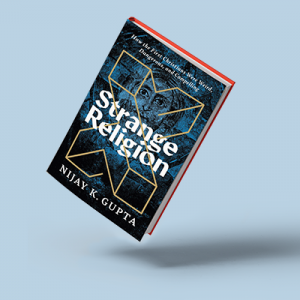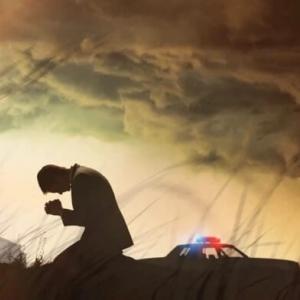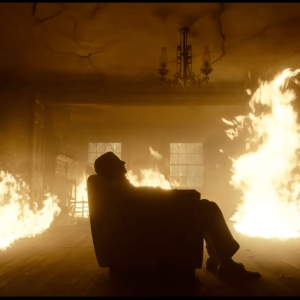
Sergio Lopez is an author, historian, and vice mayor of his hometown of Campbell, Calif. He graduated from Yale University and at Duke Divinity School. His work has appeared in TIME, Teen Vogue, America, National Catholic Reporter, Geez, and more. His writing can be found here.
Posts By This Author
How Did the Cross Become a Christian Symbol of Hope?
In ‘Strange Religion,’ Nijay K. Gupta explores how the early church was weird, dangerous, and compelling.
AROUND MY NECK hangs a cross made of polished pear wood and brushed steel. Growing up, I was taught that it was a timeless, universal reminder of Christian faith. But as Nijay K. Gupta reveals in a new book, Strange Religion, it can also be seen as a tangible reminder of another truth: The earliest Christians were weird.
As Gupta writes, “Weird is not always bad ... weird can be good. But weird can also be dangerous.” This danger was precisely why the earliest Christians were regarded with suspicion, even fear, by the Romans. “Christians had no temples, no priests, and no cult statues,” Gupta writes. “They had no sacred legends or texts of their own in the first century. ... They went out and intentionally tried to spread their religious practices far and wide.” Because the power of the Roman Empire depended on the strength of its civic religion and practices, “this naturally brought [early Christians] under suspicion” by the authorities. A threat to the religious status quo was seen as directly undermining the stability of the state.
Gupta focuses his latest book on the decades after the crucifixion when the church was becoming established.
Trying Really Hard To Be Good
The novel 'Martyr!' portrays a search for meaning amid the mess of living.
MARTYRS HAVE IT easy, thinks Cyrus Shams, the 20-something protagonist of Kaveh Akbar’s debut novel. “Why should the Prophet Muhammad get a whole visit from an archangel? Why should Saul get to see the literal light of heaven on the road to Damascus?” At least they had clarity and purpose, Cyrus reasons.
In Akbar’s Martyr!, Cyrus, a first-generation Iranian immigrant, is an aspiring poet and martyr. His problem, he thinks, is that he doesn’t know what to die for.
Cyrus’ mother Roya was killed when she was a passenger on a jet that was shot down by a U.S. warship (inspired by the real-life downing of Iran Air Flight 655). Her death leaves a gaping wound in the Shams family: Cyrus is haunted by survivor guilt and his father self-medicates with alcohol. Martyr! is in part a meditation on the inherited weight of history and grief.
This burden seems particularly true for immigrants in the U.S. — or anyone who carries the weight of multiple identities. Sociologist and activist W.E.B. Du Bois wrote about the “double consciousness” of Black Americans, who have historically carried within themselves at minimum two narratives: the American dream as well as the nightmare.
Hozier's Inferno
The album “Unreal Unearth” weaves together biblical and mythological imagery to take the listener on an epic journey.
HOZIER IS AN artist known for using biblical, religious, and mythological allusions to make sense of the complexity of human relationships. So, it’s appropriate that he begins Unreal Unearth, his newest and third album, at the beginning. The opening track, “De Selby (Part 1),” serves as a musical preamble that recalls one of the most striking and haunting scenes in the Bible: Genesis 1. Lyrically, Hozier takes us to the very beginning, the Spirit floating, formless, above the void. In a sort of abstract for the album, he sings of “the likes of a darkness so deep / that God, at the start, couldn’t bear.” It was a depth of aloneness so “intolerable,” Hozier explains on his YouTube channel, that God “had to create the world.”
The rest of the album is structured as an epic journey that draws on biblical wellsprings for inspiration. Hozier has spoken publicly about being inspired by Dante’s Inferno. As he journeyed through the isolation and devastation of the pandemic, Hozier saw his story reflected in the 14th-century text by the Italian poet who realized the only way out of the underworld — and into the light — is through it.
Why Aretha Franklin was ‘The Queen of Gospel’
Half a century later, "Amazing Grace" — the best-selling gospel album of all time — still speaks to the Black experience and touches the souls of all.
TOWARD THE END of the film documenting the performance of Aretha Franklin’s album Amazing Grace, the singer sits at a church piano. Like so many times in her childhood, she begins playing — gradually, almost tentatively — the opening chords to “Never Grow Old.” It was her first single, released when she was 14. As she sings of “a land where we’ll never grow old,” built by “Jesus on high,” folks in the audience — including gospel pioneer Clara Ward — cannot help but get up and dance. “Never, never never” — and then a Franklin trademark: mmm-mmm-mmm — “never grow old,” she testifies. You believe her.
This year, Aretha’s Amazing Grace turned 50. The album — recorded live at New Temple Missionary Baptist Church in Los Angeles with James Cleveland’s Southern California Community Choir and one of the greatest backing bands in all of pop music history — blends and crosses boundaries of genre, generation, race, and class. In 1972, Amazing Grace was not just a return to Aretha’s roots, but a vision of a future — one rooted in the Black experience in the U.S.
The liner notes credited Gene Paul as “assisting engineer.” Today, he is a legendary producer. Paul traces the genesis of Amazing Grace to Aretha’s 1972 record Young, Gifted and Black. That album’s title track, penned and first sung by Nina Simone, was a breakthrough in the civil rights and Black pride movements. “In the whole world you know / there’s a million boys and girls / who are young, gifted and Black,” the lyrics proclaim. While recording Young, Gifted and Black, Paul told Sojourners, Aretha began to conceptualize the live recording of a gospel album as a follow-up. When she thought of the potential project, Paul said, she “was smiling, captivated.” To Paul, there is a clear through line from Young, Gifted and Black to Amazing Grace: The former spoke to the contemporary Black political moment; the latter looked back in time while pulling her spiritual and cultural roots into the present. Both pointed the way to a Black future that was joyous and free.
Faith, Doubt, and Murder in ‘Under the Banner of Heaven’
The show is based on Jon Krakauer’s 2003 book of the same title, detailing the brutal 1984 murder of a woman and her infant baby by two brothers from the Lafferty clan, a prominent family in the Church of Jesus Christ of Latter-day Saints.
In ‘Nightmare Alley,’ a Carnival of Sin
Despite the discomfort some viewers might feel from the film’s visceral violence, Nightmare Alley is ultimately an old-fashioned morality tale, one in which del Toro refuses to let his central character escape the weight and judgment of his own actions. The film barrels towards the moment when Stan’s schemes fall apart with unrelenting brutality, and eventually Stan’s machinations begin to unravel. Nightmare Alley also thrills in the strong performances of characters: Cate Blanchett’s Dr. Lilith Ritter, cool and unflappable, always in control even when she seems not to be; Toni Collette’s Zeena, whose love is more complex than it initially appears.
Now If You're Looking For a Savior, Well, That's Not Lorde
Lost in much of the promotional hype leading up to Solar Power was the quiet news that in the interim between her previous album and her latest, Lorde had started therapy. Famously private, she didn’t share much more than that, but she doesn’t need to — and anyway, the new sonic landscape of the album speaks for itself. Whereas the propulsive and explosive beats of Melodrama mirrored the rhythm of thoughts racing out of your control, the bubbly basslines of Solar Power reflect the steady progression of growth she’s experienced in the years since.






